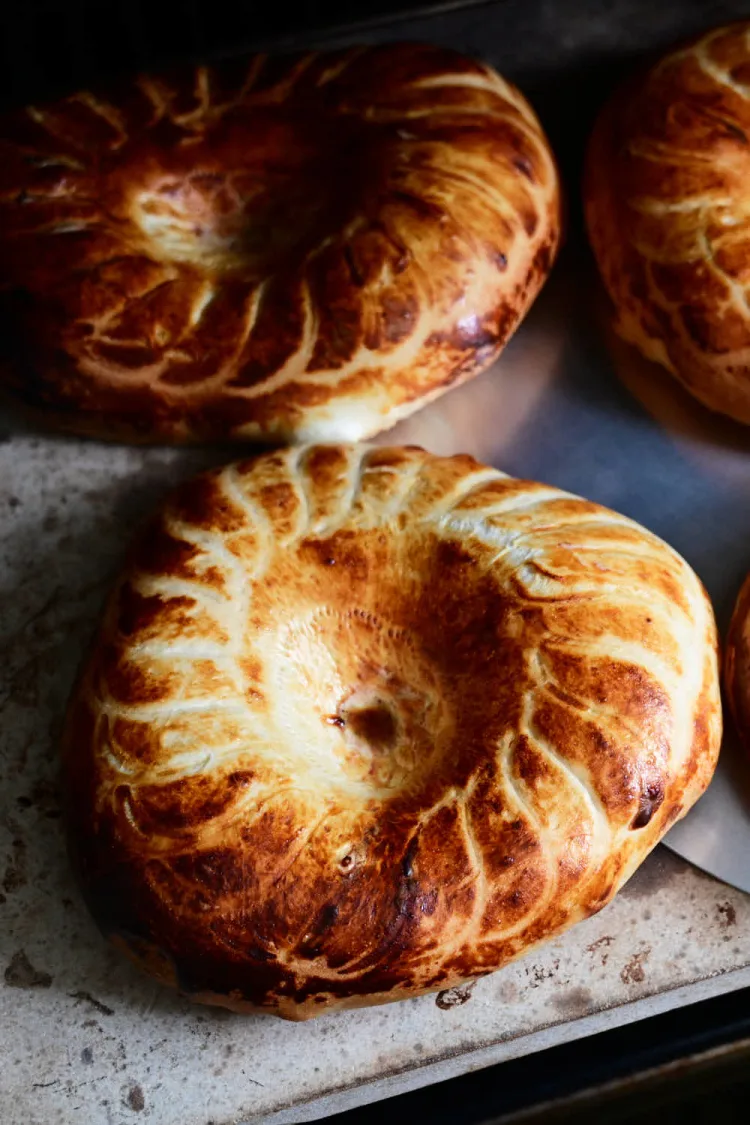
Obi Non (Traditional Bread)
A round flatbread with a decorated center, traditionally baked in a tandoor oven.
Ingredients
- •Flour
- •Water
- •Yeast
- •Salt
- •Milk
- •Sesame seeds
Instructions
Make Dough
Mix ingredients and knead until smooth
First Rise
Let dough rise until doubled
Shape
Form into rounds and stamp center pattern
Bake
Bake in hot oven until golden
Obi non is the quintessential Uzbek bread - a round, flat bread with a beautifully decorated center and a puffy, golden-brown rim. Each region of Uzbekistan has its own style of obi non, but all share the characteristic stamped pattern in the center, traditionally made using a chekich (bread stamp) that not only creates an artistic design but also helps the bread cook evenly.
The history of obi non dates back thousands of years, with the earliest versions being baked in tandoor ovens by ancient civilizations along the Silk Road. In Uzbek culture, bread is considered sacred - it's never placed upside down, and elders break the bread to begin a meal. The distinctive shape, with its raised rim and depressed center, comes from the traditional baking method where the bread is slapped onto the hot walls of a tandoor oven.
Making authentic Uzbek obi non requires skill and practice. The dough is made from flour, water, yeast, and sometimes milk for richness. After the first rise, the dough is shaped into rounds and the center is pressed down to create the characteristic depression. The bread maker then creates intricate patterns using a chekich and sprinkles sesame seeds over the top. While traditionally baked in a tandoor, home bakers can achieve good results using a very hot conventional oven and a baking stone.
While the classic version is topped with sesame seeds, regional variations might include nigella seeds, poppy seeds, or onions. Some bakers add milk or butter to the dough for a richer taste, while others might incorporate pumpkin or potato for unique flavors. In the Ferghana Valley, you'll find larger, softer obi non, while Tashkent is known for its smaller, crispier versions.
In Uzbekistan, obi non is present at every meal and is often eaten on its own as a snack. It's traditionally torn by hand, never cut with a knife, and shared among family members. Fresh from the oven, it's often served with tea for breakfast or used to scoop up various dishes during lunch and dinner. During special occasions, stacks of obi non are displayed as a symbol of abundance and hospitality.
From a nutritional perspective, a piece of obi non contains approximately 150-200 calories, primarily from carbohydrates. It's generally low in fat unless enriched with butter or oil. The bread contains gluten, so it's not suitable for those with celiac disease or gluten sensitivity. When made with whole wheat flour, it can be a good source of fiber and B vitamins. Obi non can stay fresh for several days when properly stored, though like most breads, it's best enjoyed fresh from the oven.
